Note: You can read my travelogue on the world famous Ellora Caves here
Travel has always fascinated
mankind. It caters both to the senses as well as the intellect. There is no
denying that theoretical knowledge is important. But, bookish knowledge can
only take us so far in our quest to unravel the mysteries of the world. The following
quotation, taken from the Holy Quran, underlines the importance of travel in
understanding the world we live in: “Don’t tell me how educated you are, tell me
how much you have travelled.” India is a land of such incredible cultural
diversity that traveling the entire length and breadth of it is no less remarkable
feat than traveling across one whole continent. India’s rich diversity is beautifully summed
up by the famous Hindi adage “Kos kos par badle paani, char kos par vani”
which says that such is the multifariousness of our country that the taste of
water changes after one mile while the language of people changes after four.
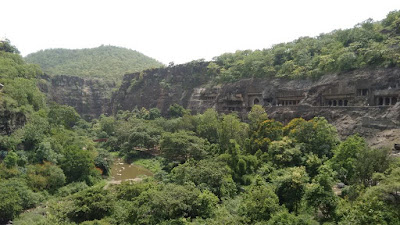 |
| Ajanta Caves: The Façade |
For all long as I can remember
I have been fascinated by the Indian cave architecture. Although I had history
as a subject only till Class X, it was enough to make me fall in love with
Indian art and culture. Whenever one speaks of the Indian rock-cut
architecture, one is automatically reminded of the Barabar Caves in Bihar,
built around the 3rd century BC. E.M. Forster’s A Passage to India
mentions of a trip to the fictitious Marabar Cabes which most probably are modeled
on the Barabar Caves. Some other well-known caves include the Bhaja, Karla,
Bedse, and the Kanheri Caves. But nothing comes close to matching the majestic
beauty of the Ajanta Caves. It's difficult for me to describe in words how happy I felt when a twist of fate presented me with an opportunity to travel to Aurangabad last month. Needless to day, it was a chance of a lifetime to explore the world famous Ajanta and Ellora Caves.
 |
| Ajanta Caves: Mural painting of Vajrapaṇi Bodhisattva |
Situated in the Aurangabad
district of Maharashtra, the Ajanta Caves comprises about 30 rock-cut Buddhist
cave monuments which date from the 2nd century BC to about 480 or 650 AD. The
caves contain the finest surviving examples of Indian paintings and sculptures.
In fact, the mural paintings are masterworks of Buddhist religious art, with
figures of the Buddha and depictions of the Jataka tales. Ajanta is about 104
kilometres from the city of Aurangabad while its distance from from Jalgaon
railway station, situated on the Delhi – Mumbai line and Howrah-Nagpur-Mumbai
line of the Central Railway zone, is 59 kilometres. They are 100 kilometres from
the Ellora Caves, which contain Hindu and Jain temples as well as Buddhist
caves.
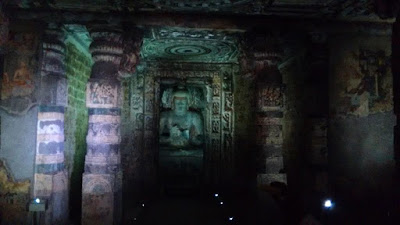 |
| Ajanta Caves: A grand Buddha sculpture inside one of the caves |
The earliest group of caves
consists of caves 9, 10, 12, 13 and 15A, made during the period 100 BC to 100 AD,
probably under the patronage of the Satavahana dynasty. Of these, caves 9 and
10 are stupa halls of chaitya-griha (place of worship) form, and caves 12, 13,
and 15A are viharas (monastry). The first phase is still often called the
Hinayana phase when the Buddha was revered symbolically. The first Satavahana
period caves lacked figurative sculpture, emphasizing the stupa instead, and in
the caves of the second period the overwhelming majority of images represent
the Buddha alone, or narrative scenes of his lives.
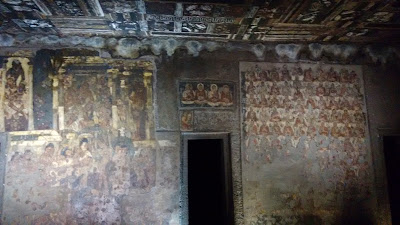 |
| Ajanta Caves: A mural painting specimen |
The second phase began in
the 5th century. For a long time it was thought that the later caves were made
over a long period from the 4th to the 7th centuries BC] but recent studies by Walter
M. Spink have argued that most of the work took place over the very brief
period from 460 to 480 BC, during the reign of Emperor Harishena of the Vakaṭaka
dynasty. The second phase is often called the Mahayana phase. Some 20 cave
temples were simultaneously created, for the most part viharas with a sanctuary
at the back. The most elaborate caves were produced in this period, which
included some renovation of earlier caves. Caves of the second period are 1–8,
11, 14–29, some possibly extensions of earlier caves. Caves 19, 26, and 29 are
chaitya-grihas, the rest viharas.
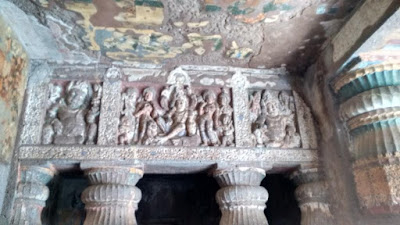 |
| Ajanta Caves: A fine specimen of sculpture art |
Mural paintings survive from
both the earlier and later groups of caves and show that by Satavahana times
the Indian painter had mastered the art of easy and fluent naturalistic painting,
dealing with large groups of people, as evident in the majestic depictions of the
Jataka tales. Four of the later caves have large and relatively well-preserved
mural paintings and fall into two stylistic groups, with the most famous in
Caves 16 and 17. All the paintings appear to be the work of painters and show a
familiarity with and interest in details of the life of a wealthy court. The
paintings in cave 1 concentrate on those Jataka tales which show previous lives
of the Buddha as a king, rather than as an animal or human commoner, and so
show settings from contemporary palace life.
 |
| Ajanta Caves: The Reclining Buddha in Cave 26 |
The Ajanta caves are situated
on the south side of a U-shaped gorge on the Waghur River. The site being abandoned
and gradually forgotten got covered by jungle until it was accidentally
rediscovered in 1819 by a British officer on a hunting party. The caves are
numbered 1 to 28 according to their place along the path, beginning at the
entrance. Several are unfinished and some barely begun and others are small
shrines. The caves form the largest corpus of early Indian wall-painting with
few other survivals being able to match its grandeur. The caves were built in
two phases starting around the 2nd century BC, with the second group of caves
built around 400–650 BC (460–480 BC according to the latest estimation). The
site is a protected monument in the care of the Archaeological Survey of India and
has been a UNESCO World Heritage Site since 1983.
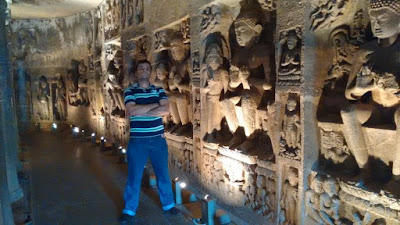 |
| Ajanta Caves: Inside Cave 26 |
As I explored some of the most grandiose of the human creations, I was overcome by an overwhelming sense of humility. I was reminded of the greatness of our selfless ancestors (the artists didn't even bother to put their names on their masterful paintings/sculptures) as well as own my insignificance when juxtaposed against those humongous man-made structures.
Accommodation: You can find all kinds of hotels (depending upon your budget and needs) in Aurangabad and Jalgaon. Also, there is a Holiday Resort in Fardapur run by Maharastra Tourism Development Corporation.
Visiting the Caves: Based on your preferred mode of transport, you can opt for rented cars, taxis or state transport department buses from Jalgaon to travel to Ajanta. The caves are open to the public from on all days from 9 am to 5:30 pm, except Mondays.
In my next article, I will talk about my visit to the Ellora Caves.
7 Wonders of India: Ajanta Ellora Caves (YouTube)
References:-
1). Wikipedia
2). ASI Website
Readers, please feel free to share your thoughts/queries by leaving your comments in the comment box. As always your feedback is highly appreciated!
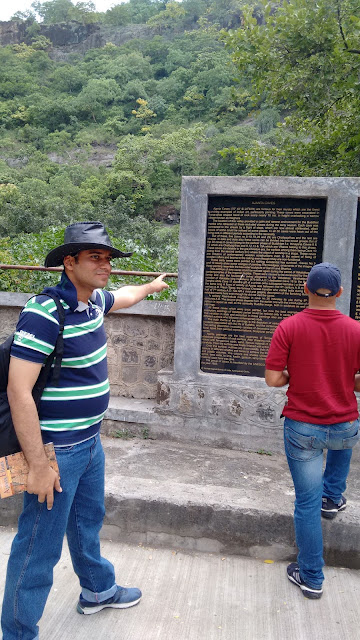
No comments:
Post a Comment